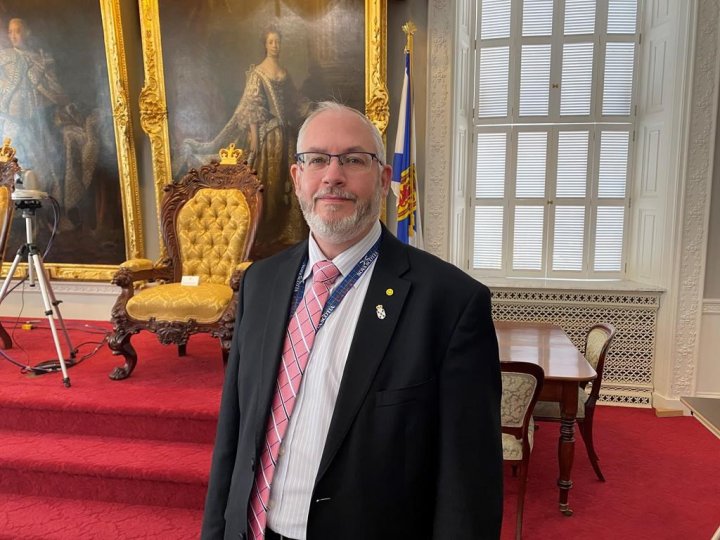
Steve Angst’s 11-year opioid addiction started with a workplace injury.
Angst was working at a Cami Automotive assembly plant in Ontario when he injured his right shoulder in 1991. The 56-year-old, then 28, needed reconstructive surgery.
After working on his shoulder, doctors prescribed Demerol to help with the pain. A few years later, in 1993, Angst needed more surgery to repair damage resulting from a fall. Then in 1996, he needed another operation on his left shoulder.
He went to his doctor for the pain — working at the plant required repetitive motion — and was prescribed Percocet. From there, his troubles with opioids got out of control.
“I got to the point where I couldn’t do anything unless I took a Percocet,” he said.
“And then, of course, the Percocet didn’t work anymore, so I go to the doctor and they just prescribe more Percocet.”
As his body built up a tolerance to the drugs, they became less and less effective for his pain. Back at his doctor’s office, Angst was prescribed OxyContin to help with his discomfort.
“It was, ‘Well, you’re on the Percocet, so we’ll give you some OxyContin that you can take with the Percocet,’” he recalled his doctor saying.
READ MORE: Drug deaths in B.C. continue to fall, but 3 people are still dying every day: coroner report
He was told OxyContin was a slow-release medicine that was safe. Angst said his doctor said the opioid wasn’t addictive, either.
“I bought into it, let’s put it that way,” he said.
But, the more prescription pain medication he was on, the higher his tolerance to it became. As his pain continued, he went back to the doctor, looking for more relief. This time, Angst said, he was prescribed a fentanyl patch.
“So I had a fentanyl patch on my left arm, I was taking 20 Percocets a day, and 160 milligrams of OxyContin at the same time,” he said.
“In the end, I don’t think it was really working for pain, to be totally honest. It was more of a getting high. But it was a high that if you didn’t have it, you couldn’t start your day.”
WATCH BELOW: Opioids and doctor-prescribed addiction in Canada. Caryn Lieberman reports.
-PKG_ONLINE_848x480_1578233411745.jpg?w=1040&quality=70&strip=all)
Many patients like Angst have been prescribed opioids for pain.
In 2018, 3.7 million Canadians aged 15 and older used an opioid pain medication, recent government data shows. According to Health Canada, between 2015 and 2016, one out of every seven people in Ontario filled an opioid prescription. This means that more than nine million opioid prescriptions were filled in the province during that period. These prescriptions can include codeine after wisdom tooth removal, for example, or hydromorphone for ongoing pain.
Statistics Canada also found that around one in 10 Canadians who used an opioid medication reported problematic use — and it’s costing lives.
WATCH BELOW: ‘Your heart breaks’: Ontario woman shares how her brother got addicted to opioids

From January 2016 to September 2018, more than 10,300 died from an apparent opioid overdose, according to the latest government data. Out of all of these overdoses, 73 per cent of deaths involved fentanyl or fentanyl-related substances.
The Canadian government has declared the opioid crisis a public health emergency.
But before thousands began losing their families, jobs and lives to opioids, many were introduced to the drugs through a prescription. The drugs were marketed aggressively to doctors beginning in the mid-1990s by pharmaceutical companies as being safe, non-addictive, and effective for pain relief, said Dr. Meldon Kahan.
READ MORE: For more than five years he was addicted to opioids. This is one man’s story of recovery
Kahan, the medical director of the Substance Use Service at Women’s College Hospital and an associate professor in the Department of Family Medicine at the University of Toronto, said Purdue Pharma, the manufacturer of OxyContin, would tell docs that there was no limit to how much a patient could take.
The drug company would host lavish events where they would “educate” health-care providers about their drug, Kahan said. The addiction expert said that these Purdue “drug dinners” happened throughout Canada.
“They would have wine and really nice food, and they would get these speakers — doctors — who they paid a lot of money, and they would have hundreds of doctors come out to these events,” Kahan told Global News.
Kahan said that Purdue had “carefully honed” several “key messages” that they wanted to hammer home to doctors.
“And furthermore, their particular product, OxyContin, was even less addicting than the alternative, which was Percocet or oxycodone. They also said that opiates were remarkably effective in treating chronic pain … and not only were they very effective, but they were incredibly safe — even at extremely high doses.
“In fact, there was no dose limit.”
WATCH BELOW: Toronto physician describes how Purdue Pharma pitched opioids to docs

What’s more, Kahan said that Purdue insisted doctors were “opiate-phobic” if they denied patients painkillers, arguing that they had an “irrational” fear of opiates.
“They dramatically changed physicians’ prescribing of opiates,” Kahan said. “The interesting thing is that these messages were false, and they knew them to be false at the time, and they didn’t care. And even when evidence emerged — which was pretty quickly — that people were dying of OxyContin overdoses, they still persisted.”
Opioid manufacturers are now being hit with numerous lawsuits across the U.S. and Canada.
Purdue is being sued by more than 1,000 U.S. state and local governments for allegedly triggering the opioid epidemic and lying about the effectiveness and safety of OxyContin. Purdue denies the allegations, arguing the U.S. Food and Drug Administration-approved labels for its opioids carried warnings about the risk of abuse and misuse associated with pain treatments.
In Oklahoma, Johnson & Johnson and subsidiary Janssen Pharmaceuticals are being sued for more than US$17 billion by the state for their alleged role in fuelling the opioid crisis. The state alleges the drug company used overly aggressive marketing tactics and misled doctors about the risks of opioid use, leading to thousands of overdose deaths over the past decade in the state. Johnson & Johnson products include a fentanyl patch named Duragesic and an opioid-based pill called Nucynta.
In Canada, British Columbia — a province that has been heavily affected by the opioid crisis — has also sued Purdue, as well as other companies associated with the epidemic.
READ MORE: Opioid overdose deaths continue to increase in Canada: PHAC
Another claim filed in May in Ontario seeks more than $1.1 billion in damages from almost two dozen of the biggest pharmaceutical names in the country, including Apotex, Bristol-Myers Squibb and Johnson & Johnson. The suit is filed on behalf of patients who became addicted to prescribed opioids and argues that drug companies were negligent in how they researched, developed and marketed opioids beginning in the 1990s.
Counsel for the plaintiffs told Global News that none of the defendants have filed statements of defence.
Purdue Pharma Canada said in a statement to Global News that it is “deeply concerned” about the opioid crisis across Canada and acknowledged the class-action lawsuit. “We are continuing to review the lawsuit and will determine next steps in due course.”
Outside the courtroom, studies show how the drug epidemic in North America has unfolded.
Research from the University of British Columbia (UBC) found that higher prescription rates in B.C. were linked to more overdoses.
A 2017 report from the Canadian Centre on Substance Use and Addiction said that 37 per cent of opioid-dependent patients admitted to Toronto’s Centre for Addiction and Mental Health (CAMH) reported “receiving opioids solely from physician prescriptions, compared to 26 per cent of patients who received opioids from both a prescription and ‘the street.'”
Other research from UBC found that rates of long-term opioid use for non-cancer pain increased in B.C. between 2005 and 2012, and more than two in 10 of all B.C. residents were long-term users of prescription opioids in 2012.
(Research has found that opioids are not very effective for treating chronic non-cancer pain, and any benefits are likely to be small.)
WATCH BELOW: Mothers losing children to fentanyl overdoses speak out on small community in crisis

A different study by UBC researchers and B.C. public health officials found that those who overdosed on opioids between 2015 and 2016 were more likely to have been prescribed an opioid for pain and used a prescription opioid long-term in the past five years.
At the time of overdose, the study found 92 per cent of men and 86 per cent of women did not have an active opioid for pain prescription, and approximately half had not filled one in the past five years.
In other words, based on research and doctors interviewed for this piece, people who overdosed on opioids may have been introduced to the drug through “liberal” prescribing practices, but once addicted to opioids, they often overdosed on illicit or illegally obtained drugs.
This was the case for Michael Mahoney, who died from a fentanyl overdose in 2018 at the age of 21.
Michael was prescribed a nasal opioid spray when he was just 13 years old after a stomach condition left him in severe pain and unable to eat. When his pain didn’t go away, a pain specialist prescribed the young teen Dilaudid (hydromorphone) tablets, said his mother, Jan Mahoney. Dilaudid is an opioid used to treat moderate to severe pain.
“At the time, nobody told me to be concerned about addiction because they believed if he was in pain and he was taking opioids, he would not develop an addiction,” she said. “That was the theory in the medical community.”
But Mahoney, who lives in Victoria, B.C., said that by the time her son’s prescriptions ran out, he had developed a dependency on opioids. He had only just finished Grade 8.
“He finally went off the Dilaudid and later in the summer he told me, ‘Mom, you know, getting off those pills was really, really hard. I think I was addicted to them,’” she said.
Mahoney believed her son was not using drugs until she learned otherwise when he was in Grade 10.
READ MORE: Canadian life expectancy has stopped rising because of the opioid crisis: Statistics Canada
Michael also had a mood disorder, attention deficit hyperactivity disorder, and obsessive-compulsive disorder, and was using drugs to cope. In his second year of high school, Michael had a mental breakdown and was admitted to a psychiatric hospital.
“After that, the drug use just got worse and worse,” Mahoney said.
Mahoney, a retired nurse, and her husband, who works in government, tried to get Michael professional help. Mahoney said certain treatment centres wouldn’t take Michael because of his combined mental health and addiction issues, and when she finally did find a centre in Burnaby, B.C. that treated both, he was put on a waitlist. Mahoney said Michael’s application sat for months as she called health-care centres, desperate for help.
When she learned Michael’s application was finally approved, it was too late.
“They had accepted him as a patient, but they still hadn’t put him on the waiting list for a bed, and the next day he overdosed,” she said.
“He went downtown and unfortunately bought a tainted Dilaudid tablet and died of fentanyl poisoning.”
Twenty-nine-year-old Nicole McAlpine of Hamilton, Ont. is desperately trying to find drug-free treatment for her pain.
An ice slipping accident in February left McAlpine with a “smashed” knee, and so far, all she’s been offered to cope is drugs. She can’t get around without crutches and has gone from emergency rooms to specialists desperate for answers.
McAlpine recently went to the emergency room at St. Joseph’s Health Centre in Toronto when her leg became so swollen that she couldn’t stand on it. There, she told doctors that she was getting worse, and her family doctor and previous emergency room doctors had not been able to help her.
She said the emergency room doctor at St. Joseph’s offered her Dilaudid, but she refused.
WATCH BELOW: Alberta man struggling with opioid addiction explains why supervised consumption facilities are important

McAlpine said she was then given an anti-inflammatory at the hospital, but was sent home with a prescription for gabapentin, an anticonvulsant medication commonly used to treat seizures and neuropathic pain, and hydromorphone, an opioid.
She has had addiction issues in the past and said she doesn’t want to use opioids.
“Not one of these doctors, aside from my family physician, asked if I was on other medications,” McAlpine said.
As McAlpine waits for more specialist appointments and answers for what is going on with her knee, she is taking Tylenol 3s, CBD pills and Gabapentin to cope with her pain.
“I’m trying to regulate it all that I can,” she said.
Dr. Lori Montgomery is a Calgary-based chronic pain physician who works with people who use opioids. Montgomery, who is an associate lecturer at the University of Calgary and medical lead of the Alberta Health Services’ Calgary Pain Program, said there are ways to treat pain outside of drugs.
Cognitive behaviour therapy (CBT) and rehabilitation to retrain the brain and nervous system, for instance, are ways to successfully manage pain.
“When you have chronic pain, your pain system is responding really aggressively with pain responses to virtually every stimulus that comes in,” Montgomery said. “And we need to retrain your nervous system, so we turn the volume down on those signals, and your pain isn’t as intense.”
READ MORE: More doctors are prescribing opioids to prevent their patients from dying of overdoses
Montgomery said these kinds of strategies last longer and have fewer side effects and downsides compared to medications. The problem, however, is that CBT and rehabilitation are poorly funded and patients often have to pay out-of-pocket, whereas drugs are cheaper and easier to prescribe.
“Physician services and medications are funded in every province with essentially no limit,” she said. “And, unfortunately, access to providers who can provide CBT and rehabilitation is almost universally not funded … and increasingly a lot of physicians are learning to do those things themselves because that’s the only way that their patients have access to them.”
This is worrisome because, for people who’ve been prescribed opioids and have developed an addiction or dependency, the effects of their drug use may be long-lasting.
Montgomery said that the long-term effects of opioid dependency are not yet fully understood, and there needs to be more research on how using opioids for many years affects mental and physical health. So far, Montogmery said research shows that long-term opioid use has “pretty significant effects” on the endocrine system.
“For example, when you take opioids for a long time, it can affect your thyroid, it can affect blood sugar, it can affect your bone density and testosterone,” she explained. “Virtually everyone who takes opiates long-term has almost undetectable testosterone levels.”
WATCH BELOW: New numbers shed new light on opioid crisis in Alberta

Montgomery said more research is needed to understand if testosterone levels can be restored after stopping opioids, as well as the effects the drugs have on the brain. She said it’s probable that brain structure is changed by long-term opioid use.
Research out of Harvard University on the effects of opioids on the brain found “significant morphological and functional changes” in parts of the brain related to affect and impulse control, as well as in regions connected to reward and motivational functions.
Angst said he’s experienced firsthand the long-term effects of opioid addiction. Even though he’s been off the drugs for about 15 years — save for a brief four-month relapse in 2009 after a doctor gave him Percocet — his mind and body are not the same.
“I sit in my basement in pain and I shake and shiver,” he said. “I had to have my son help me unlock my door to get me into my house a week ago because my hands were shaking so badly that I couldn’t get the key in the lock.”
His personality has changed from using opioids, too. Angst said he was once a social butterfly but now, he is more of a recluse.
READ MORE: Ontario government will join B.C.’s proposed class action against opioid manufacturers
“I was a guy that wanted to go to the bars and party all the time with people, playing hockey … going to shoot pool after work, and hanging out with the boys, stuff like that,” he said.
It’s been nearly a year since her son died and Jan Mahoney wants to raise awareness about the realities of opioid addiction and the challenges many Canadians face when trying to access help.
She believes her son’s death did not need to happen, and he should never have been turned away so many times for treatment.
Angst said when trying to seek help for his own opioid addiction, he was faced with many obstacles, too. Prescriptions for opioids were handed to him, but addiction services were not.
He was turned away from treatment centres and said he felt belittled when he tried to get help at a methadone clinic. Eventually, he detoxed on his own, at his house, with members of his church coming to check on him. Former coworkers had struggled with opioid addiction, too, and some didn’t make it.
Today, he stays away from opioids.
“Fifteen years down the road, here I am after having a couple surgeries from an injury and I sit in my basement and I shake when I’m in pain,” he said.
“I can’t take anything for it because everything for pain is based on opiates, more or less.”
Laura.Hensley@globalnews.ca









Comments